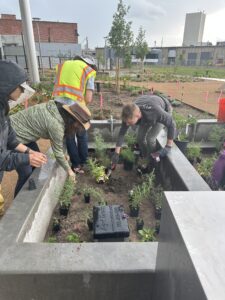
In the semi-arid Colorado climate, long periods of hot and dry conditions are often broken up by rapid torrential rains. Stormwater runoff can contribute to water pollution and cause flooding and erosion, creating a paradox of water being precious and scarce, yet hazardous and contaminated.
What if stormwater could instead be collected in biological green spaces to minimize runoff and filter the water for reuse as irrigation?
Two CSU researchers are collaborating with municipal officials in Denver to improve urban landscaping design for green stormwater management systems. Professors Sybil Sharvelle, civil and environmental engineering, and Jennifer Bousselot, horticulture and landscape architecture, have joined forces to integrate green infrastructure and stormwater reuse into the urban landscape.
The many dimensions of water and vegetation
The multi-faceted project will examine how different types of captured water (i.e., graywater, stormwater, etc.) affect various combinations of soil and vegetation. Additionally, the researchers will collect data on vegetation in street-level planters and green roof systems that will maximize the removal of toxins and pollutants from water.

“Typically research focuses on one element. By approaching this work with equal weight given to the agriculture side and the engineering side, we have a robust project that is more valuable and useful to the end users,” said Bousselot, an expert in green roof development and urban horticulture.
By testing different sources of water, soil, and vegetation, their research will identify ideal combinations for urban landscaping that reduces pollution, minimizes damage from flooding and runoff, and sustainably treats and reuses stormwater. The four-year project will also capture how the vegetation responds in each weather season in Colorado.
CSU Spur serves as collaborative hub
At the Hydro Building of CSU Spur, the team has access to concrete test plots in Hydro’s Backyard to function as experimental bioretention cells mimicking streetside planters commonly found in urban landscapes. Spur’s Hydro Building also has a green roof space for testing the viability of vegetation irrigated with different non-potable water types.

“I love that Spur serves as a space to connect CSU’s agriculture and water engineering programs where we have enhanced collaboration opportunities. We can work on projects in the same location, and with the Terra Building right beside the Hydro Building, it is an area for elevated research where students get great experience,” said Sharvelle, an expert in urban stormwater management and head of the Water Technology Acceleration Platform Lab (Water TAP) at Spur.
“The outdoor lab at Hydro is a great place to interact with the public. I think school kids will love to visit, learn about how we are trying to protect our water resources, and hopefully be inspired to help too,” stated Colin Bell, Senior Engineer at the Division of Green Infrastructure within the Department of Transportation and Infrastructure for the City and County of Denver.
Sharvelle and Bousselot are co-advising civil engineering PhD student Amanda Guedes Salerno. Salerno will manage plant growth, measure water outflow from the bioretention cells and green roof, and other hands-on data collection at Spur. She earned her undergraduate degree in environmental engineering in her home country of Brazil, then came to CSU for a master’s degree in horticulture.
Her current PhD research is in many ways a continuation of her master’s research with green roof systems.
“The facility at Spur is amazing,” said Salerno. “As a master’s student, I studied green roof infrastructure but had to perform research in small simulation boxes. Now, we can access the fully functional green roof at Spur. The integration between the water science and horticulture science in one place is incredible.”
Partnering for the public good
The results of this research will provide guidance on stormwater treatment, water quality improvement, and the viability of vegetation in bioretention cells and green roof systems. The guidance will then inform future projects by the Division of Green Infrastructure and the Denver metro area’s Mile High Flood District (MHFD), who are jointly funding the project.
“This has been a really exciting collaboration with our local utilities and municipal partners. We are able to perform research and water quality testing at a level they may not have the resources for, and it has a direct impact on them,” said Sharvelle.
The Director of Research and Development at Mile High Flood District, Holly Piza, shared “The CSU and MHFD partnership at Spur allows us to connect academic research with practitioners in our region. This research is informing our regional criteria and advancing the practice of stormwater management.”
“It’s a great team. CSU brings the research expertise and an amazing facility, MHFD has a strong history of developing innovative stormwater criteria, and DGI will use the findings to build on an existing network of over 200 facilities in Denver,” said Bell.